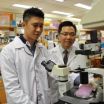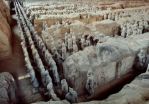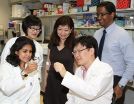(Press-News.org) Spinal cord injury (SCI) currently ranks second after mental retardation among neurological disorders in terms of cost to society. Pain is a debilitating consequence of SCI related to the nature of the lesion, neurological structures damaged, and secondary pathophysiological changes of surviving tissues1. Approximately two-thirds of persons who have sustained SCI experience clinically significant pain after injury, of whom one-third have severe pain2, 3. Post-SCI pain can increase with time and is often refractory to conventional treatment approaches4. Over the past decade, clinical studies have shown that post-SCI pain interferes with rehabilitation, daily activities, and quality of life and may substantially influence mood, leading to depression and even suicide4-7.Chronic neuropathic pain following SCI is divided into three types: at-level pain (pain within the body segments innervated by spinal cord segments at the level of the injury), below-level pain (pain within body segments caudal to the level at which the spinal cord was injured), and above-level pain (pain within body segments rostral to the level at which the spinal cord was injured)8. The mechanisms underlying SCI-induced chronic neuropathic pain are not well understood. Aberrant central sprouting of nociceptive fibers has been commonly proposed as a mechanism of SCI pain and is associated with mechanical allodynia induced by SCI9-11. Demyelination (loss of myelin) and dysmyelination (abnormal myelination) induced by oligodendrocyte injury and death are important contributors to SCI-associated behavioral deficits, including pain12-16. For instance, SCI-induced dysmyelination is involved in the aberrant sprouting of nociceptive fibers and causes SCI pain behaviors. Thus, remyelination of demyelinated/dysmyelinated axonsin the injured spinal cord could be an important repair therapy for SCI and one of the key elements for functional recovery and aberrant sprouting prevention after SCI, published in the Neural Regeneration Research (Vol. 9, No. 5, 2014).
INFORMATION:
Article: " Effect of microenvironment modulation on stem cell therapy for spinal cord injury pain" by Sufang Liu1, 2, Changsheng Li1, 2, Ying Xing2, 3, Feng Tao1 (1 Department of Anesthesiology and Critical Care Medicine, Johns Hopkins University School of Medicine, Baltimore, Maryland 21205, USA; 2 Basic Medical College, Zhengzhou University, Zhengzhou, Henan Province, China; 3 Basic Medical College, Xinxiang Medical University, Xinxiang, Henan Province, China)
Liu SF, Li CS, Xing Y, Tao F. Effect of microenvironment modulation on stem cell therapy for spinal cord injury pain. Neural Regen Res. 2014;9(5):458-459.
Contact: Meng Zhao
eic@nrren.org
86-138-049-98773
Neural Regeneration Research
http://www.nrronline.org/
Effect of microenvironment modulation on stem cell therapy for spinal cord injury pain
2014-08-01
ELSE PRESS RELEASES FROM THIS DATE:
Acrolein as a novel therapeutic target for motor and sensory deficits in spinal cord injury
2014-08-01
Acrolein, a highly reactive unsaturated aldehyde, has been shown to play a major role in the secondary injury by contributing significantly to both motor and sensory deficits. Prof. Riyi Shi, who comes from University of Purdue in USA will highlight the recent developments in the understanding of the mechanisms of acrolein in motor and sensory dysfunction in animal models of spinal cord injury, and will also discuss the therapeutic benefits of using acrolein scavengers to attenuate acrolein-mediated neuronal damage following spinal cord injury. The relevant study has been ...
Recent advances in stem cell biology
2014-08-01
Advances in stem cell research will provide enormous opportunities for both biological and future clinical applications. Basically, stem cells could replicate any other cells in the body, offering immense hope of curing Alzheimer's disease, repairing damaged spinal cords, treating kidney, liver and lung diseases and making damaged hearts whole. The potential for profit is staggering. Prof. Jinhui Chen from Indiana University in USA considered that this field of research still faces myriad biological, ethical, legal, political, and financial challenges. The eventual resolution ...
Developmental regulation of important plant phloem components discovered
2014-08-01
Sieve elements are a key component of phloem, the conductive tissue through which plants transport carbohydrates and a wide range of signalling molecules. Elongated cylindrical cells are capped at one end by a sieve plate and arranged end-to-end to form sieve tubes which in turn form a network throughout a plant's body.
"Sieve elements are very special cells which play an important role in carbon sequestration, yet so far very little has been known about their differentiation," says Professor Ykä Helariutta from the Institute of Biotechnology, University of Helsinki, ...
Plastic surgeons or nurses: Who are the better injectors?
2014-08-01
In recent years, minimally invasive aesthetic injectable procedures have grown in popularity as more and more men and women are seeking age-defying treatments. As Botulinum toxin – generally known as BOTOX® – use has increased, a growing number of nonaesthetic health professionals have emerged to perform procedures utilizing this and other injectables. Kevin Small, MD and Henry M. Spinelli, MD from the Division of Plastic Surgery Presbyterian Hospital in New York and Kathleen M. Kelly, MD from Columbia University in New York have assessed the capability of various providers ...
'Active' surfaces control what's on them
2014-08-01
CAMBRIDGE, Mass-- Researchers at MIT and in Saudi Arabia have developed a new way of making surfaces that can actively control how fluids or particles move across them. The work might enable new kinds of biomedical or microfluidic devices, or solar panels that could automatically clean themselves of dust and grit.
"Most surfaces are passive," says Kripa Varanasi, an associate professor of mechanical engineering at MIT, and senior author of a paper describing the new system in the journal Applied Physics Letters. "They rely on gravity, or other forces, to move fluids or ...
'Wetting' a battery's appetite for renewable energy storage
2014-08-01
RICHLAND, Wash. – Sun, wind and other renewable energy sources could make up a larger portion of the electricity America consumes if better batteries could be built to store the intermittent energy for cloudy, windless days. Now a new material could allow more utilities to store large amounts of renewable energy and make the nation's power system more reliable and resilient.
A paper published today in Nature Communications describes an electrode made of a liquid metal alloy that enables sodium-beta batteries to operate at significantly lower temperatures. The new electrode ...
NUS study shows effectiveness of common anti-malarial drug in controlling asthma
2014-08-01
Asthmatic patients may soon have a more effective way to control the condition, thanks to a new pharmacological discovery by researchers from the National University of Singapore (NUS).
The team, led by Associate Professor Fred Wong from the Department of Pharmacology at the NUS Yong Loo Lin School of Medicine, together with Dr Eugene Ho Wanxing, a recent PhD graduate from the Saw Swee Hock School of Public Health at NUS, discovered that artesunate, a common herbal-based anti-malarial drug, can be used to control asthma, with better treatment outcomes than other drugs ...
Preterm children do not have an increased risk for dyscalculia
2014-08-01
Preterm children do not suffer from dyscalculia more often than healthy full term children. Dr Julia Jäkel, a developmental psychologist from Bochum, and her colleague Prof Dr Dieter Wolke from the University of Warwick, UK proved this thesis to be true in their analyses – thus refuting previous scientific studies. Unlike other studies, the researchers took the children's IQ into consideration.
Dyscalculia in preterm children often impossible to diagnose
Preterm children often have cognitive deficits; they find solving complex tasks particularly difficult. However, ...
Scientists solve 2000-year-old mystery of the binding media in China's polychrome Terracotta Army
2014-08-01
Even as he conquered rival kingdoms to create the first united Chinese empire in 221 B.C., China's First Emperor Qin Shihuang ordered the building of a glorious underground palace complex, mirroring his imperial capital near present-day Xi'an, that would last for an eternity.
To protect his underworld palaces, the First Emperor issued instructions that his imperial guard be replicated, down to the finest details, in red-brown terracotta clay, poised to do battle. Thousands of these imperial guards were initially discovered in 1974; some contained patches of pigment that ...
Taking the guesswork out of cancer therapy
2014-08-01
Researchers and doctors at the Institute of Bioengineering and Nanotechnology (IBN), Singapore General Hospital (SGH) and National Cancer Centre Singapore (NCCS) have co-developed the first molecular test kit that can predict treatment and survival outcomes in kidney cancer patients. This breakthrough was recently reported in European Urology, the world's top urology journal.
According to IBN Executive Director Professor Jackie Y. Ying, "By combining our expertise in molecular diagnostics and cancer research, we have developed the first genetic test to help doctors prescribe ...



